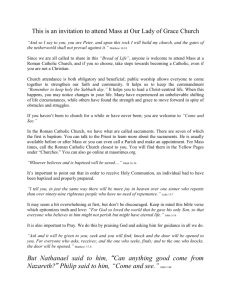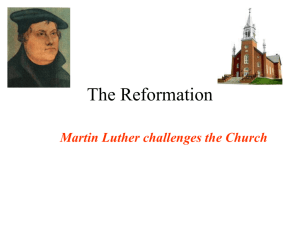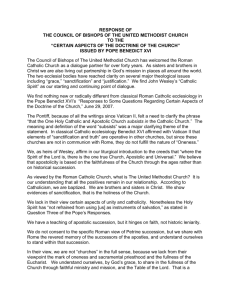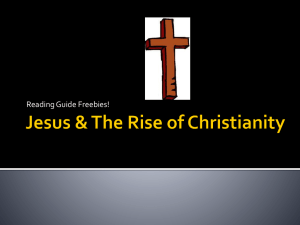HISTORY OF CHRISTIANITY 100 – 1517 A.D. INTRODUCTION The
advertisement
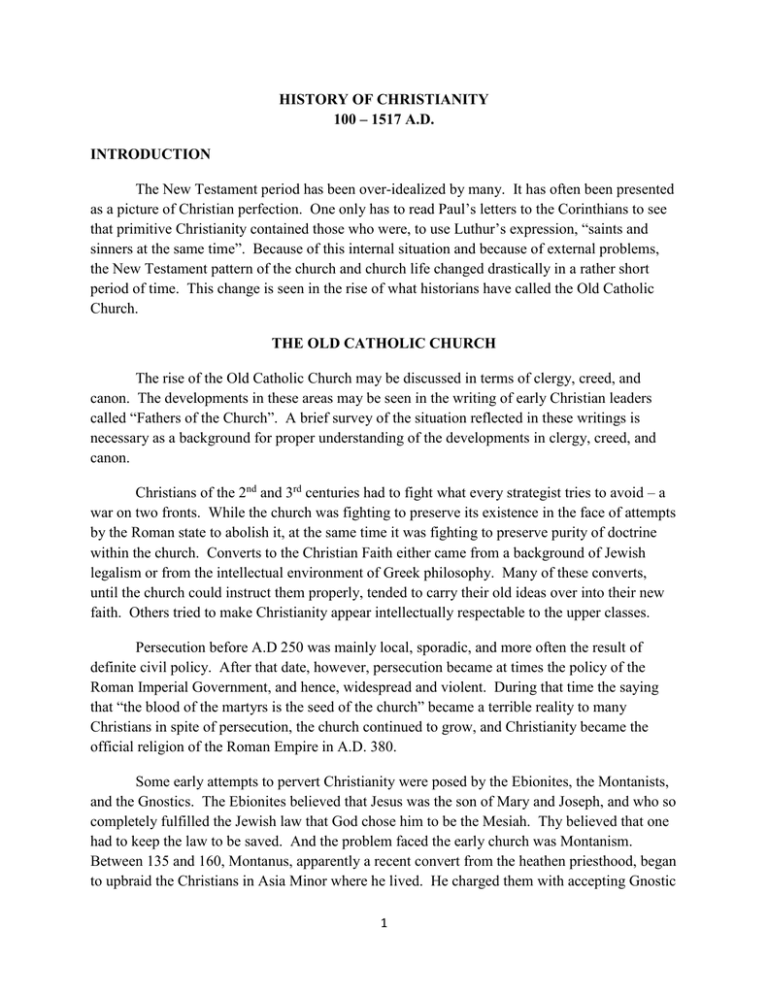
HISTORY OF CHRISTIANITY 100 – 1517 A.D. INTRODUCTION The New Testament period has been over-idealized by many. It has often been presented as a picture of Christian perfection. One only has to read Paul’s letters to the Corinthians to see that primitive Christianity contained those who were, to use Luthur’s expression, “saints and sinners at the same time”. Because of this internal situation and because of external problems, the New Testament pattern of the church and church life changed drastically in a rather short period of time. This change is seen in the rise of what historians have called the Old Catholic Church. THE OLD CATHOLIC CHURCH The rise of the Old Catholic Church may be discussed in terms of clergy, creed, and canon. The developments in these areas may be seen in the writing of early Christian leaders called “Fathers of the Church”. A brief survey of the situation reflected in these writings is necessary as a background for proper understanding of the developments in clergy, creed, and canon. Christians of the 2nd and 3rd centuries had to fight what every strategist tries to avoid – a war on two fronts. While the church was fighting to preserve its existence in the face of attempts by the Roman state to abolish it, at the same time it was fighting to preserve purity of doctrine within the church. Converts to the Christian Faith either came from a background of Jewish legalism or from the intellectual environment of Greek philosophy. Many of these converts, until the church could instruct them properly, tended to carry their old ideas over into their new faith. Others tried to make Christianity appear intellectually respectable to the upper classes. Persecution before A.D 250 was mainly local, sporadic, and more often the result of definite civil policy. After that date, however, persecution became at times the policy of the Roman Imperial Government, and hence, widespread and violent. During that time the saying that “the blood of the martyrs is the seed of the church” became a terrible reality to many Christians in spite of persecution, the church continued to grow, and Christianity became the official religion of the Roman Empire in A.D. 380. Some early attempts to pervert Christianity were posed by the Ebionites, the Montanists, and the Gnostics. The Ebionites believed that Jesus was the son of Mary and Joseph, and who so completely fulfilled the Jewish law that God chose him to be the Mesiah. Thy believed that one had to keep the law to be saved. And the problem faced the early church was Montanism. Between 135 and 160, Montanus, apparently a recent convert from the heathen priesthood, began to upbraid the Christians in Asia Minor where he lived. He charged them with accepting Gnostic 1 ideas, with following human leadership instead of the Holy Spirit in church life and organization, and with becoming very lax in Christian discipline. Montanus magnified two doctrines, the Second Coming of Christ to reign from Phrygia, and the Holy Spirit. Montanus often spoke as if he were the Holy Spirit, or even the Father, not just a divine instrument, thus giving his pronouncements divine sanction. This posed a grave threat to the authority and jurisdiction of the established clergy, Montanism splintered the churches in Asia Minor. The greatest threat to the early church was Gnosticism. Though some of the New Testament writings appear to be dealing with Gnosticism, it reached the height of its influence about 150. This movement taught that salvation came through a secret knowledge which it possessed and that spirit was good, but matter was evil. This dualism tended to undercut the doctrines of creation, incarnation, and salvation. Neither Gnosticism nor Montanism, though extremely perilous, was ever embraced by a majority of Christians, the church remained, more or less, faithful to historic Christianity. By the latter third of the second century it was calling itself the “catholic” church. The word “catholic” was first used of the church by Ignatius, who used it in the non-technical sense of “universal”. Its employment as a technically descriptive adjective gradually became common, so that the somewhat consolidated church that came out of the Gnostic and Montanist crises is now usually described as the “Old Catholic Church”. It developed many of its distinguishing characteristics between 160-190 A.D. The hitherto relatively independent congregations were now knit into an effective union. The power of the bishop was greatly strengthened, a collection of authoritative New Testament scriptures recognized and a creed formatted. Christianity now became a rather rigid corporate body, having recognized official leaders and being capable no merely of defining its Faith, but of shutting out from its communion all who did not accept its creed or its offiers. The hange can be summarized as follows: About 150, he was of the church who had received baptism and the Holy Spirit and called Jesus Lord; About 180, he who acknowledged the rule of faith (creed), the New Testament canon, and the authority of the bishops. How all this came about may be discussed, as stated earlier, under the headings of clergy, creed, and canon. In the New Testament period, leaders were on the same level as the people but served because they had been given special gifts by the Holy Spirit. However, the original equality among the several pastors, bishops, and elders serving in a church began to disappear. In the New Testament there appears to be no difference between a bishop and a presbyter, the two names simply describing functions of the one office (Acts 20:17-35). Quite early in the second century, however, it became common for one minister to assume leadership, sometimes because of unusual scholarship, Christian maturity, or strong personality. The bishop (overseer) became distinguished from the elders (presbyters). The appearance or a single bishop with authority over his congregation and with the prestige of an alleged connection with the apostles (apostolic succession) is the first major development in the history of the Catholic hierarchy. Though the development did not take place at the same time everywhere, the bishop began extending his 2 authority from a single church to a group of churches known as a diocese. The strongest bishops (assuming titles as archbishop or patriarch or metropolitan) presided over councils attended by bishops and presbyters from adjacent territory and began looking toward extending their jurisdiction even further. The influence of the bishop developed in other directions too. The church came to be conceived as a saving institution with the saving sacraments of baptism and the Lord’s Supper. And who within the church controlled these sacraments? The bishop, or course. The view became current that only the bishop personally possessed the essential power of the church. Bishop Cyprian of Carthage could say in about 250 that “the bishop is in the church, and the church is in the bishop, and that if anyone is not with the bishop he is not in the church”. Another significant development was in the creedal area. This had to do with a statement of faith, of things which must be believed in order for one to be considered a Christian. The basic New Testament affirmation is the confession of Peter: “thou art the Christ, the Son of the living God” (Matthew 16:16). Unfortunately, information about the instruction of converts in the first century is lacking. With a change in outlook in the second century, however, the need for a binding statement of faith was felt. With the growth of the idea of the church as a saving institution, it was necessary for one to be in communion with the church. Ex-communication meant exclusion from the communion, but no one could be admitted to communion who did not believe what the church believed. That then was the church’s faith? We know that by 150 some form of instruction before baptism was common. Subjects recited a creed and at baptism were asked a series of questions concerning their faith. Out of such statement the “Apostles’ Creed” arose, appearing first in Rome between 150-175, the first confession of faith of any length of which we know. Other important creeds came out of the ecumenical councils of the church held at Nicea (325) and Chalcedon (451). The Nicene Creed dealing with the divinity of Christ and the Chalcedonian dealing the with person of Christ became, with minor refinements, normative for Catholic orthodoxy. The first creed said that Christ was fully divine, not less than God, and the Chalcedonian Creed maintained that in his person Christ was fully human and fully divine. The third significant factor in the Old Catholic Church had to do with the Canon, a collection of inspired books by which faith and practice could be measured. This was made all the more necessary because Marcion, a Gnostic leader, put together a canon. Marcion included some of his own writing, the Gospel of Luke, and ten of Paul’s letters, all carefully edited so as to satisfy his beliefs. The church, from earliest times, reckoned the Old Testament as scripture. However, the selection of the books of the New Testament was a process that covered many years. The first official document which prescribes the 27 books of our New Testament as a lone canonical is Alexandrian Bishop Athanasius’ Easter Letter for the year 367. Basically, there were three 3 criteria in the selection of books for the New Testament. FIRST – a book must have been written by an Apostle or one closely associated with an Apostle. SECOND – the teaching of a book had to be in accord with the Old Testament revelation and the oral teaching passed on by the Apostles. THIRD – there was the matter of consensus of Christian opinion concerning the book. The ultimate choice, the church believed, was by the Holy Spirit as He led in the choice of books. ROMAN CATHOLICISM The development which led to the rise of the Old Catholic Church set the stage for the Roman Catholic Church. When the bishop of Rome came to the place of supremacy over other bishops, then we can speak of the church as the Roman Catholic Church. How did the Bishop of Rome come to a place of primacy? Several factors were involved. FIRST – historical events conspired to enhance his reputation. Rome, the largest city in the west, had been the transitional center of authority for the Roman world for a long period of time. When Constantine moved the capital of the Empire to Constantinople in 330, this left the Roman Bishop as the single strongest individual in Rome, and the people of the west came to look to him for temporal as well as spiritual leadership. SECOND – the Petrine theory based on Matthew 16:18:“thou art Peter, and upon this rock I will build my church” tradition connected the Roman church with Peter and Paul, and considered the bishops of Rome as successors of Peter. The Perrine text, however, was not seriously used as a biblical foundation for primary until the time of Bishop Damascus (366-384). Increasingly strong claims on behalf of this verse were made in the years to follow. For example, Leo I (440-461) was dominated by the conviction that the Lord had committed to him, the spiritual heir and successor of Peter, the care of the whole church. It is interesting that among seventy-seven so-called “Fathers and Doctors of the church” which have written on Matthew 16:18 only seventeen interpreted the rock to refer to Peter. At least four other factors can be briefly mentioned which are: Doctrinal wisdom, able men, loss of competition and effective missionary work. Most of the time the able and ambitious Bishop of Rome was on the right side in doctrinal controversies. Though at one time there were as many as five patriarchs, the destruction of Jerusalem in AD70 and the Moslem conquest of Antioch and Alexandria left only Constantinople as a weak rival of Rome. Meanwhile, the Roman Church brought much territory under her control by effective, widespread missionary work. What date shall we give for the beginning of the Roman Catholic Church? Rome, or course, says from the time of Peter. Others disagree. Scholars use the time of Bishops Innocent I (402-604), Leo I (440-461), or Gregory I (590-604) as marking the beginning. 4 The origin of the Roman Catholic Church was when the Bishop of Rome was able to effectively dominate the other bishops. Perhaps this can be linked to the reign of Leo I, and he may rightly be call the First Pope. What do Roman Catholics believe in addition to the idea that the Bishop of Rome is the successor of Peter and the earthly head of the church? The briefest way to get at the heart of Roman Catholic thought is to look at The Seven Sacraments of that church. Many protestants do not think that the Roman Church believe in grace. How untrue this is can be seen from the fact that grace is a vital key in the thought of Thomas Aquinas (12251274), the greatest theologian of the Roman Catholic church. It should be stressed, though, that the church dispenses grace through the Seven Sacraments. FIRST – God’s grace comes through baptism which washes away all previous sin and puts the soul in a state of grace (salvation). With the growth of the doctrine of original sin and the idea that baptism was the instrument of salvation (as early as 2nd and 3rd centuries), infant baptism came into vogue. Since death is uncertain, one should be baptized as soon as possible to wash away the infection of original sin. NOTE: Baptism is necessary for membership in the church. It is administered to both infants and adults by poring and all baptized persons are considered church members. SECOND – Penance is necessary to take care of post-baptismal sins, though confession to a priest, who offers absolution and assigns satisfaction. Though God forgives the eternal punishment of the penitent, certain temporal penalties remain which must be satisfied as the priest directs. If adequate satisfaction is not made in this life, it must be completed in a place called purgatory. THIRD – The Roman Catholic view of the Lord’s Supper became fixed by the Fourth Lateran Council in 1215, in a belief called transubstantiation. At the words of consecration by the priest a miracle is wrought by the power of God, so that while the “accidents” of bread and wine (taste, shape and the like) remain watered, their “substance” is transformed into the body and blood of Christ. This sacrament is considered to be the continuation of the Incarnation, the repetition of the passion, the source of spiritual up-building to the recipient and the evidence of his union with Christ. 5 FORTH – Confirmation serves as a source of spiritual strength to live the Christian life. FIFTH – Extreme unction, often called last rites, involves anointing a person with “holy oil” by the priest, giving the person grace in the face of death and preparing his soul for the next life. SIXTH – Is the sacrament of marriage that gives a couple divine aid to fulfill the Christian purpose of marriage. SEVENTH – Ordination transmits apostolic authority by the laying on of the bishop’s hands to the one being ordained, enabling that person to dispense the sacraments. Did everyone agree with what was taking place in what we call the Roman Catholic Church? NO, because from the early years of Christianity there were differences which would result in a split between Eastern and Western Christianity. The EAST was more mystical while the WEST was more practical minded. There was rivalry between the Bishop of Rome and the Patriarch of Constantinople. Rome used unleavened bread in the Lord’s supper while Constantinople used leavened bread; Rome allowed only bishops to administer confirmation; Constantinople allowed priest to do so. Rome added a word to the Nicene Creed which taught that the Holy Spirit proceeded from the Father and the Son (Filoque). There were differences about how to observe lent. Finally, Patriarch Michael Cerularius (1043-1058) and Pope Leo IX (1049-1054 excommunicated each other in 1054, and Roman Catholicism and Eastern Orthodoxy went their separate ways. In addition to the East-West split, there were various dissenting groups which arose from time to time protesting developments within Christendom. As a result of the Renaissance, the growth of nationalism, an may other factors, these movements resulted in the Protestant Reformation which will be divided into several phases, the Lutheran, the Reformed, the Radical, and the Anglican. SUMMARY Roman Catholicism 1. The Roman Catholic Church dates its beginnings to the moment of Christ’s selection of Peter as guardian of the keys of heaven & earth … and as chief of the apostles, and it claims this fisherman as its first Pope. 2. The Roman Catholic Church gained its authority and power when it arose as the only body strong enough to rule after the fall of the city of Rome in 410. 3. The 1st mention of the term Catholic (universal) Church was made y Ignatius about 110115 A.D. 6 4. Augustine deeply influenced the Roman Catholic theological and philosophical structure, and he gave the papacy its finest justification and defense. He left it strong enough to give crowns or deny them to Europe’s kings. 5. As time went on there came the temptations of power and prosperity from within the church and opposition to its growing power and prosperity from without. 6. Roman Catholic scholars admit there were corrupt individuals within the church, that many of its members had sinned and that some of its leadership had done wrong and some type of reform was necessary. So, actually, reform was under way before the Reformation broke out. 7. Martin Luther was a catholic reformer before he became a protestant and because of him the Roman Catholic Church suffered its most fateful division. 8. Two other reasons for the revolt: First – the growth of nationalism and secularism … the ambitions of political princes and rulers who had great personal ambitions who wanted no interference from the church, Second – The revival of the Greek and Roman pagan influences and emphases. 9. The 1st Roman Catholic diocese (group of churches) on this side of the Atlantic was establish in Greenland in 1125 … the first permanent parish in America was at St. Augustine, Florida in 1565. 7

